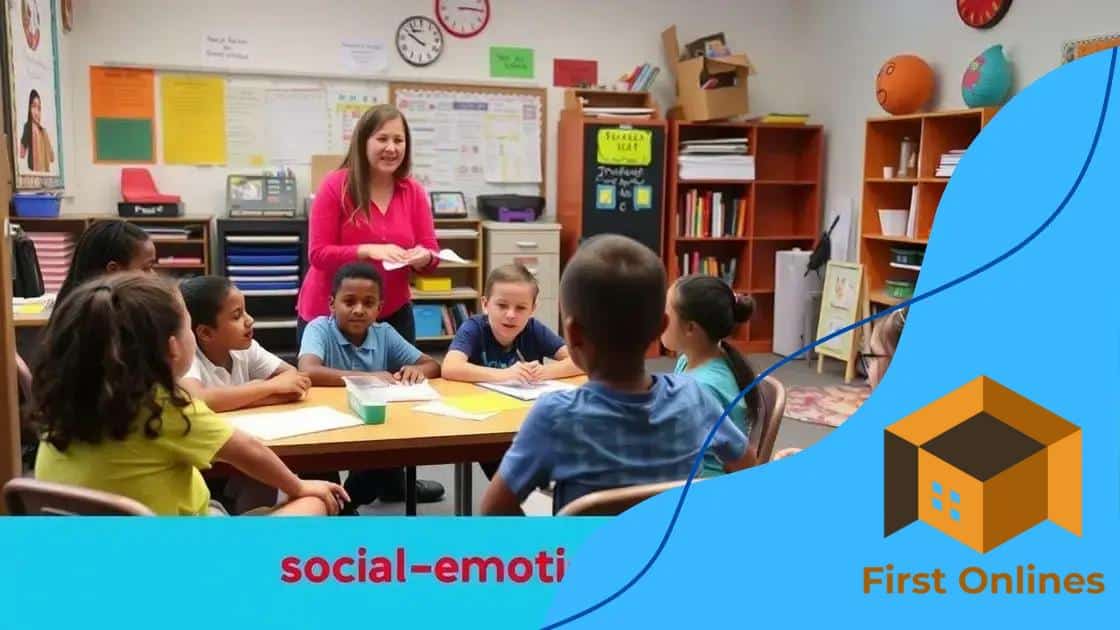The role of social-emotional learning in modern schools

Anúncios
The role of social-emotional learning in modern schools is essential for developing students’ emotional intelligence, fostering positive relationships, and enhancing academic performance through effective classroom strategies and consistent program assessment.
The role of social-emotional learning in modern schools is crucial for fostering student well-being and improving academic outcomes. Have you ever wondered how emotions and relationships influence learning? Let’s dive into the importance of SEL in today’s educational landscape.
Anúncios
Understanding social-emotional learning
Understanding social-emotional learning is essential for creating supportive educational environments. It involves helping students recognize and manage their emotions while developing strong interpersonal skills that enhance their relationships and academic performance.
Social-emotional learning (SEL) encompasses several key components that are vital for student success. These components include emotional awareness, relationship skills, social awareness, self-management, and responsible decision-making. Understanding these elements will allow educators to implement effective strategies that nurture development.
Key Components of SEL
Recognizing the vital aspects of SEL is crucial for understanding its impact on students. They include:
Anúncios
- Emotional awareness: The ability to identify one’s own emotions and the emotions of others.
- Relationship skills: Developing positive relationships and effective communication abilities.
- Self-management: The capacity to manage stress and control impulses.
- Social awareness: Understanding and respecting diverse perspectives and cultural differences.
By focusing on these components, schools can create programs that effectively address the diverse needs of students. Social-emotional learning is not just about individual growth; it also fosters a caring community within the school. This contributes to a more engaged and responsible student body.
The Importance of SEL in Education
Integrating social-emotional learning into daily lessons is beneficial for students. It helps in improving overall mental health and academic performance. When students feel safe and connected, their motivation and engagement levels increase.
Incorporating SEL into the curriculum can be done through various activities, such as group projects, role-playing, and discussions that allow students to share their thoughts and feelings. These activities not only build skills but also encourage students to connect with one another on a deeper level. By taking time to focus on SEL, educators can promote resilience in students, preparing them to face challenges both inside and outside the classroom.
Additionally, it can lead to lower dropout rates and improved classroom behavior, further supporting the idea that nurturing emotional intelligence is crucial for educational success.
By understanding social-emotional learning, educators can create a more inclusive and supportive environment that prepares students for life beyond school.
Benefits of social-emotional skills
Learning the benefits of social-emotional skills is important for students and educators alike. These skills can profoundly impact a student’s academic journey and overall well-being. When students develop social-emotional skills, their ability to connect with peers and navigate challenges enhances significantly.
Students who are equipped with strong social-emotional skills tend to perform better academically. These skills foster a deeper understanding of emotions, allowing students to engage in learning more effectively. When students can manage their emotions, they can focus better on their studies, leading to improved grades and a more positive attitude toward school.
Key Benefits of Social-Emotional Skills
Understanding the key benefits helps emphasize the value of SEL programs in schools. Some of these benefits include:
- Improved academic performance: Students who practice social-emotional skills often see an increase in their grades.
- Better social relationships: Skills like empathy and communication help students form healthy peer relationships.
- Enhanced mental health: Students can manage stress and anxiety better, leading to lower rates of depression.
- Increased resilience: Social-emotional skills help students cope with challenges and setbacks more effectively.
Additionally, nurturing social-emotional skills in students prepares them for real-life scenarios. They learn to work in teams, resolve conflicts peacefully, and make thoughtful decisions. These skills are essential as they progress into adulthood, assisting them in managing work and personal relationships successfully.
Schools that prioritize SEL create a positive environment where students feel safe and supported. In these environments, students are more willing to take risks and speak up, knowing they are valued. This leads to a more vibrant school community and contributes to higher levels of student engagement and satisfaction.
Ultimately, the long-term advantages of developing strong social-emotional skills can create a generation of empathetic and responsible adults. Investing in these skills during school years pays off in numerous ways throughout life.
Implementing SEL in the classroom

Implementing SEL in the classroom is crucial for fostering a supportive learning environment. By integrating social-emotional learning into daily lessons, educators can help students develop vital skills that benefit their academic and personal lives. Effective SEL practices set the foundation for a positive classroom culture, promoting growth and connection among students.
To successfully implement SEL, teachers can use various strategies that encourage students to practice these skills in real-life situations. One effective approach is through classroom activities that focus on teamwork and collaboration. When students work together on projects, they learn to communicate, listen, and support each other.
Strategies for Implementing SEL
Several strategies can enhance SEL implementation in the classroom. These include:
- Creating a safe space: Establishing an environment where students feel comfortable sharing their thoughts and emotions is essential. Encouraging open conversations allows students to express themselves without fear of judgment.
- Modeling behavior: Teachers should exemplify social-emotional skills in their interactions with students. Demonstrating empathy, active listening, and conflict resolution sets a strong example for students to follow.
- Incorporating SEL into the curriculum: Integrating stories and lessons that highlight social-emotional themes can engage students in meaningful discussions about emotions and relationships.
- Encouraging reflection: Providing opportunities for students to reflect on their emotions and experiences helps them develop self-awareness and emotional regulation.
Another effective way to implement SEL is through regular check-ins with students. These brief sessions allow teachers to gauge students’ emotional states and provide support as needed. By regularly checking in, teachers can identify any issues early on and foster a sense of belonging in the classroom.
Additionally, using art and music can be powerful tools for expressing emotions and promoting social connections. Activities such as drawing, role-playing, or creating music together can strengthen the classroom community. These creative outlets allow students to communicate feelings that may be difficult to express in words.
Ultimately, implementing SEL in the classroom is about creating a nurturing environment that prioritizes emotional well-being and interpersonal skills. By adopting these strategies, educators can enrich their students’ learning experiences and prepare them for future challenges.
The role of teachers in SEL
The role of teachers in SEL is pivotal to fostering emotional growth and social awareness among students. Teachers are not just instructors; they are mentors who guide students through their social and emotional development. This means creating a classroom environment conducive to learning and emotional support.
One essential aspect of a teacher’s role is modeling positive behaviors. When teachers demonstrate empathy, active listening, and effective communication, they set an example for students to follow. Students learn by observing their teachers, so embodying these values in daily interactions can significantly impact how students relate to one another.
Key Responsibilities of Teachers in SEL
Teachers have several responsibilities when it comes to implementing social-emotional learning in the classroom. These include:
- Building relationships: Establishing trust and rapport with students is crucial. When students feel connected to their teachers, they are more likely to engage and participate in class activities.
- Creating a safe environment: Teachers need to ensure that the classroom feels like a safe space. This involves setting clear expectations and encouraging respect among students.
- Facilitating discussions about emotions: Allowing students to express their feelings creates opportunities for deeper understanding. Teachers can initiate conversations about emotions and encourage students to share their experiences.
- Integrating SEL into lessons: In addition to dedicated SEL activities, teachers can incorporate social-emotional themes into their regular curriculum. This helps students see the real-life application of these skills.
It is also important for teachers to be aware of their students’ emotional states. Regular check-ins can help teachers understand how their students are feeling. By noticing changes in behavior or mood, teachers can provide the necessary support or resources.
Another effective strategy is using group activities that promote teamwork and collaboration. Through these exercises, teachers can observe how students interact and guide them in developing essential skills like conflict resolution and empathy.
Finally, teachers can engage in professional development to better understand SEL. Learning new strategies and gaining insights into emotional intelligence can enhance their teaching practices and influence their students positively.
Measuring the impact of SEL programs
Measuring the impact of SEL programs is crucial for understanding their effectiveness in enhancing students’ emotional and social skills. Knowing how to evaluate these programs helps educators and administrators make informed decisions about their implementation and improvement. A comprehensive approach to assessment can provide valuable insights.
To effectively measure the impact of SEL programs, various methods can be employed. Quantitative measures, such as surveys and standardized tests, often provide data on student outcomes. These tools can gauge improvements in areas like academic performance, attendance, and behavior.
Key Assessment Methods
Some effective ways to assess SEL programs include:
- Student surveys: Collecting feedback from students about their feelings and experiences can highlight changes in their emotional intelligence and social interactions.
- Observation: By observing student behavior in different settings, teachers can assess the application of social-emotional skills in real-time.
- Teacher assessments: Gathering insights from teachers regarding changes in students’ behavior and engagement helps paint a broader picture of SEL’s impact.
- Performance metrics: Analyzing student performance data before and after the implementation of SEL programs can showcase advancements in academic achievement.
Qualitative measures also play a vital role in understanding the depth of SEL’s impact. Conducting interviews and focus groups with students, teachers, and parents can provide richer narratives about personal growth and community building.
Moreover, using a combination of both qualitative and quantitative data can present a comprehensive view of a program’s effectiveness. A mixed-methods approach ensures that both statistical trends and personal experiences inform program evaluations.
Ongoing assessment is key. Regularly revisiting data can reveal long-term trends and areas needing attention. By continuously measuring SEL program impact, schools can adapt their strategies to better meet the needs of students.
FAQ – Frequently Asked Questions about Social-Emotional Learning (SEL)
What is social-emotional learning (SEL)?
Social-emotional learning (SEL) is the process through which students develop skills in managing emotions, establishing relationships, and making responsible decisions.
How do SEL programs impact student behavior?
SEL programs help reduce behavioral issues by promoting emotional intelligence, leading students to respond more positively in challenging situations.
What are some effective techniques for implementing SEL in classrooms?
Techniques include creating a safe environment, modeling positive behaviors, facilitating group activities, and incorporating SEL themes into the curriculum.
How can schools measure the success of their SEL programs?
Schools can measure SEL program success through student surveys, teacher assessments, observations, and analyzing academic performance data.





